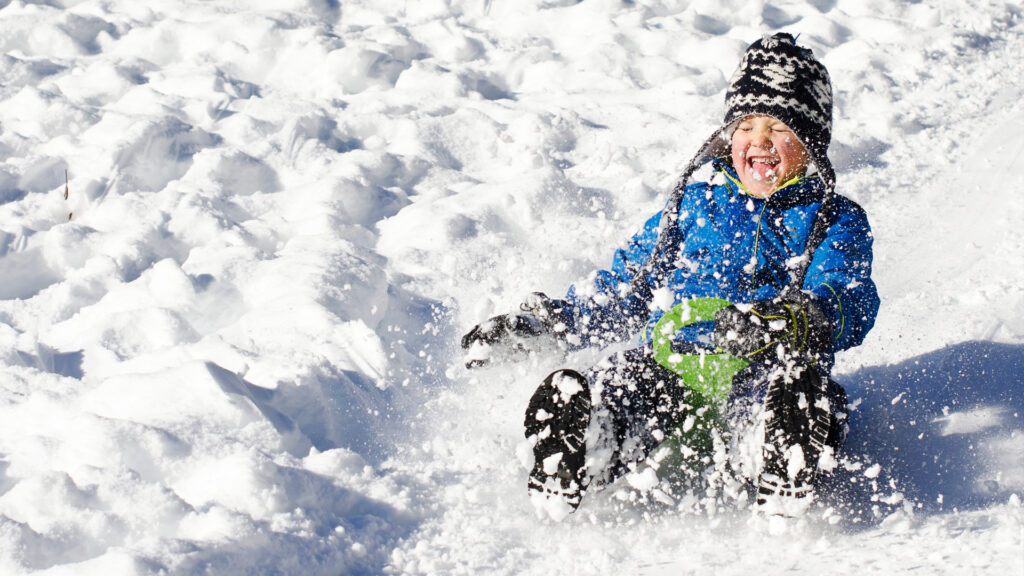We all know that winter in Northern Minnesota can be downright brutal. That’s why it’s important to take extra care in keeping our loved ones safe. How do you know what’s safe and unsafe during the coldest season of the year? With the help of Fairview Range Pediatrician Dr. Lauren Tomlinson, we’ve compiled a list of preventive measures, best practices, and helpful reminders to keep your kids healthy and warm.
What Kids Should Wear
- Rule of thumb: dress older babies and young children in one more layer than an adult would wear in the same conditions
- Dressing infants and children in several thin layers will help to keep them dry and warm; a layer that wicks moisture closest to their skin, followed by a middle layer such as a down or fleece, and an outer shell layer such as a waterproof jacket to protect from rain, snow, and wind (avoiding cotton)
- Remember not to let them outside without their warm boots, socks, mittens, and hats as your child’s head, face, ears, hands, and feet are the most exposed to the cold, which could lead to frostbite
- Always change out of wet clothes right away
- Quilts, blankets, pillows, and other loose bedding should be kept out of an infant’s sleeping environment — it is better to sleep in onesies or wearable blankets
- It’s always good to pack an extra clothes bag for children, but especially in the winter. Keep a cold clothes emergency kit in your vehicle as well
- Keep a close eye on outdoor playtime in colder conditions and watch for warning signs such as red and tingly skin that has been exposed to the cold air — if teeth are chattering it’s time to head inside
Frostbite
Frostbite is an injury caused by freezing of the skin and underlying tissue cells when exposed to cold weather for a prolonged period of time. Skin typically becomes cold, red, numb, then will turn pale, gray, then a darkened color. It is most common in the toes, fingers, nose, ears, cheeks, and skin along with other areas highly exposed to the cold. The severity of the frostbite typically depends on the wind chill, dampness, temperature, and length of exposure. Frostbite can cause serious injury, so call your doctor immediately or take your child to the emergency room if they need medical attention.
Keep in mind:
- You should not rub or massage the skin following frostbite
- Do not use direct heat to warm the skin
- Do not disturb any blisters that may arise
- You should wrap the warm areas of the body to prevent further damage and apply clean cotton or gauze between fingers and toes if they are affected
Further treatment will be determined by your doctor.
To prevent frostbite, be sure to dress your child appropriately and bring them inside to warm up with a warm snack or drink. Be sure to teach your child the signs of frostbite.
Hypothermia
Hypothermia is more severe than frostbite, as frostbite occurs when the skin has been exposed for too long; hypothermia, on the other hand, is a significant decrease in the body’s core temperature. Frostbite may or may not occur. Hypothermia is defined by the core body temperature dropping below 95 degrees fahrenheit. Young children and older adults are more likely to develop hypothermia, as well as individuals who are chronically ill, malnourished, or are under the influence of drugs or alcohol.
Hypothermia Warning Signs
Adults & Children
- Drowsiness and shivering
- Confusion and memory loss
- Slurred speech and fumbling
- Inability to think or move, weakness
- Pale and cold skin
- Slowed breathing or heart rate
- Uncontrollable shivering
Infants
- Low energy and bright red/cold skin
- Shivering and cold chest
- Pale and cold skin
- Slowed breathing or heart rate
- Uncontrollable shivering
Call 911 anytime you suspect someone has hypothermia. Provide first aid while waiting for medical assistance. If someone is displaying the warning signs of hypothermia, provide the following:
- If unconscious, check airway, breathing, and circulation. If necessary, provide CPR. If the individual is breathing fewer than six breaths/minute begin rescue breathing
- Take the child or adult to a warm room and cover with warm blankets. Cover their neck and head to retain body heat
- Help remove any wet or tight-fitted clothing and replace with dry clothing
- Warm the individual, if necessary, with your own body heat. Use a warm compress and apply it to the chest, neck, and groin areas
- If the individual is alert, you may provide warm, nonalcoholic fluids to help provide warming
- Stay with the individual until help has arrived
Remember to avoid going outside in extremely cold temperatures, immediately remove any wet clothes, and do not venture outside if you or a loved one is on certain medications or under the influence of drugs or alcohol.
Cold and Influenza (“Flu”)
Winter is the common season for runny noses, sore throats, headaches, sneezing and coughing, and chills. All the classic signs for the common cold. But, there’s a difference between your child’s common cold and influenza. A cold will gradually increase, typically over the span of a few days, whereas influenza is more commonly associated with a high fever and seems to happen suddenly. In addition, your child may experience low energy, diarrhea, and vomiting with the flu.
The best thing to do regardless of a cold or flu is to make sure your child is drinking plenty of fluids and getting sleep. While influenza typically goes away after roughly a week, for children under the age of 5, and especially under 2, there can be serious complications for their future health. Other signs may include wheezing or trouble breathing, pale skin, disinterest in eating or drinking, and dehydration.
Other important things to keep in mind:
- Make sure your child stays home from school/daycare if they are feeling ill or showing signs of flu symptoms as it is highly contagious. Typically, your child may return to school/daycare after their fever has subsided for at least 24 hours without medication.
- Do not give children aspirin
- Antiviral drugs must be taken as soon as possible. There are a variety of over-the-counter medications that are safe for children, but if you are unsure about what medication to provide your child, contact your pediatrician. They may prescribe a specific medication depending on the severity of the cold.
- Contact your pediatrician if symptoms persist or get worse, especially if they have asthma.
- Make sure your child is washing their hands to help stop the spread of cold and flu.
- Prevention is the best course of action; make sure your entire family gets their flu vaccine every year.
Is It Influenza or COVID-19?
Telling COVID-19 and influenza apart can be difficult. Both COVID-19 and influenza are infectious respiratory illnesses, but they are brought on by distinct viruses. The influenza virus causes influenza and coronavirus SARS-CoV-2 causes COVID-19. Because some of the symptoms of the flu and COVID-19 are similar, you cannot distinguish between them solely by their symptoms. If you experience symptoms, discuss getting tested for COVID-19 and the flu with a healthcare professional.
Have a Safe Winter!
Every year, winter brings new challenges to parents. Despite the potential hazards and illnesses, staying educated on signs of winter woes and how to treat them is a great way to keep your kids safe. If you do have concerns about anything – from frostbite to the flu, don’t hesitate to call your provider.



